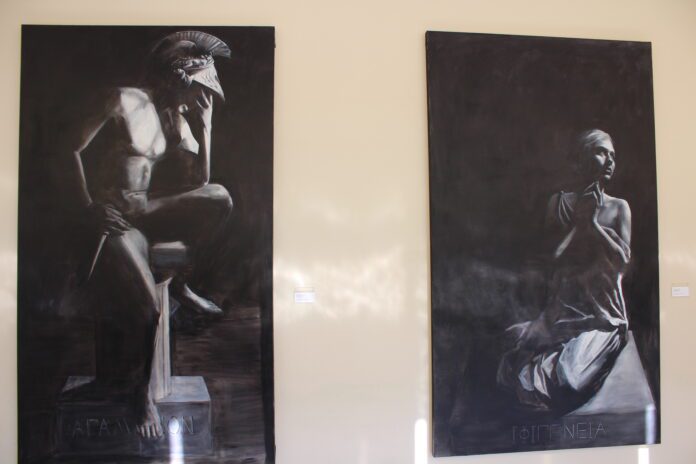
An analysis of new art pieces in the Cap Bar
If you have been enjoying an iced coffee at the Cap Bar or have been visiting Chief Greene at the UDPD office, you may have noticed a very new and very different set of paintings. Paintings of Agamemnon and Iphigenia now hang in the hallway connecting the Cap Bar to the UDPD office. These paintings were painted by Quinn Kelsch who earned a B.A. in Classical Philology in 2021 from the University of Dallas.
This is a reflection of the paintings as written by the artist: “The diptych depicts two lines from Aeschylus’ ‘Agamemnon.’ For him, it is ‘… and when he put on the yoke of necessity the breath from him came bitter…’ This line struck me for two reasons; first, the fact that Necessity can make a man into an unman, something both more and more horrible than a mere animal.
Agamemnon is shown naked except for a helmet and sword, he has stripped from himself all that separates him from the animal except the tools of war. He mourns, but his decision is made. This is indeed my second point, that although it is called Necessity, he still chooses to put on the yoke — it is delightfully ambiguous.
Turning to Iphigenia, the line is ‘and she struck her accusers with the eyes’ arrows of pity, lovely, as in a painted scene.’ Apart from being simply an utterly impeccable moment, this line seems to understand the perfection of this action. The moment is so vivid it is already as though it were in paint, as it also shall be. Her softness and her peplos contrast with Agamemnon’s cold and hard nakedness. She does not wail nor fight but communicates the gross and unnatural injustice in her father’s deed through a glance.”
I would encourage you to read the beginning of the “Agamemnon” again if it has been a while; those first pages stir me like few other things. This particular set of paintings stands out to me for a couple of reasons.
It is rare to see art contemplating the classics on campus. UD is filled with modern and contemporary art and although they do contain a certain beauty within themselves, it is refreshing to see art reflecting parts of the UD Core. These paintings not only invite students to engage in art through what they have encountered in the Core, but also contemplate the difficult themes presented in them.
One of the reasons why we encounter so many ancient texts in our Core is because these themes are universal, surpassing time and culture. Throughout all these texts, we see ourselves and the difficulties that we must bear within the characters and themes we encounter. In these particular paintings, we encounter questions of honor, loyalty and most importantly justice.
Through Agamemnon’s sin and Iphigenia’s suffering, we encounter ourselves and the questions we must face and answer in this life. What is just? What makes us different from the beasts? What does it mean to be man?
I believe that art like this is absolutely necessary for this campus. We come across so many universal themes in our Core and having art that tells the stories we come across provides for a potentially fruitful opportunity for reflection. The great books we get to study help us make an interior journey and art should allow for the same interior change. Experiencing art should always lead us to deeper reflection on truth, beauty and goodness. Ultimately, beautiful art points us to the important things in this life and allows us to sit with the higher things.